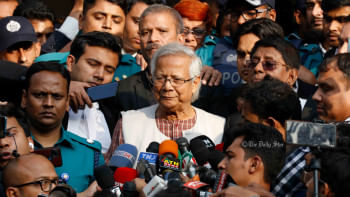Refreshing inclusion of gender diversity and sensitivity in trial textbook

The latest trial version of the seventh grade History and Social Science: Activity Book is being widely discussed for certain parts of two of its chapters. One captures a conversation on gender identity or gender diversity, and the other discusses Oborodhbashini (Secluded Women) by Rokeya Sakhawat Hossain, published in 1931 – a critique of the extreme forms of purdah imposed on women at the time. While the new curriculum may certainly be constructively criticised, these two chapters need to be commended for their transformative potential. The chapters and their discussions are both relevant and significant.
The chapter that covers a dialogue on gender diversity admirably simplifies a number of complicated issues: sex as only biological, gender as social constructions, and gender diversity as lived realities, to mention a few. The discussion unfolds the gender identity of Sharifa, who identifies herself as a woman, despite being biologically male. However, the discussion in the Bangla version may seem confusing, as it does not define the terms it uses.
Persons whose biological sex conforms with their gender identity are considered to be cisgender, and persons whose biological sex does not conform with their gender identity, are transgender. Transgender people may or may not choose to medically transition into the gender their self-perceived identity conforms with. A transgender person who chooses to transition from male to female is a transgender female, and a transgender person who transitions from female to male is a transgender male.
While "transgender" is an umbrella term, it often proves to be non-inclusive of the lived experiences of many gender-diverse people. The 2021 United Nations Independent Expert Report on Gender Identity rightly explains the shortcomings of the terminology "Transgender" or "Trans" in accounting for the gendered realities of many individuals: for instance, two-spirit persons (North America), muxes (Mexico), kathoey (Thailand), bakla (Philippines), travestis (Argentina and Brazil), fa'afafine (the Samoan islands), or leiti (Tonga).
While in the Bangla version, Sharifa refers to herself as "transgender", the English version carefully (and more intelligently) omits that terminology. The term that the UN chooses now to use to refer to persons whose gender identity and/or expression are at odds with what is enforced as a gender norm in a particular context at a particular point in time, is "gender diverse".
Both the Bangla and the English versions of the textbook perceptively emphasise the gender identity of the Hijras. Most Hijras self-identify neither as male nor female – not even transitioning – but rather as belonging to a distinct gender category, often referred to as "the third gender". It is important that students are introduced to the concept of gender identity and diversity, more especially in the present context, where (to note a few positives) Hijras and transgender people are increasingly making important contributions in different spheres of the state and public life. They have also been getting more official recognition, such as in 2019, when the Bangladesh government created a third gender category on the national voters' list.

As discrimination and violence based on gender identity and expressions is pervasive across the globe, and in most cases, the said discrimination and violence are perpetrated by people who are not sensitised to the rights of gender-diverse people, it is significant that young students are introduced to the idea of gender identity early on.
Curiously, gender identity has never been part of our curriculum before. This, however, does not imply that we can simply shut our eyes and deny gender identity as a reality. This discussion has the potential to help students grow up to be respectful of gender-diverse people, see them as equals, and also acknowledge the privileges of being cisgender that we often take for granted (similar to the privileges enjoyed by men within patriarchal societal structures or by White people in societies where people of colour are discriminated against).
The other chapter that has garnered attention covers parts from Oborodhbashini – a feisty critique of patriarchal society from the early 1930s. The entire discussion in Oborodhbashini is utilised under the heading "When the social context changes, the status and role of the individual also changes" to show how social conditions and circumstances that regulate individuals' lives, change with time.
The critique by Rokeya was published at a time when women were not accepted as political equals (with even equal voting rights, for instance) across the world. It was only in the late 1920s that women in Bengal, for instance, won the right to vote on a limited scale. Snippets from Oborodhbashini thus represent a gendered time and social context, where women were relegated to reclusion and perceived as "lesser" than men on all counts. In many colonial-era legislations, we also find references of "pardanashin ladies" and specific rules applicable to them in the colonial legal context. Such women – both Hindu and Muslim, and mostly belonging to the upper class – customarily and culturally had to observe complete reclusion.
Oborodhbashini must be academically appreciated for its radical feminist zeal, at a time when women could not freely assert their rights and equality with men. It is important that such texts then inspire students to discuss arbitrary mandatory impositions of dress codes of any kind, on any grounds, by any authority – on anyone, including women – as violations of their right to freely express themselves.
The themes in Oborodhbashini is also relevant for students to appreciate how, with social and temporal changes, the lives of individuals change too. It can inspire them to appreciate women's accomplishments, success stories and equal contribution with men in society at large, and to also think of areas where women still lag behind men in terms of the rights that they still cannot fully exercise.
Against the backdrop of the bleak state of women's human rights in 2022, where we witnessed women in Afghanistan losing rights to education and work, and women in Iran losing rights even to life and basic security, the gender lessons in the trial version of the seventh grade textbook are refreshing.
It is only necessary now to add some discussions on intersectionality, equality and non-discrimination too, in order to flesh out the points that have already been made. It is also necessary to make the Bangla and English versions more aligned with each other. Finally, it is important that the educational institutions also receive some sort of sensitisation, so they can discuss these topics and make the best of them in an academic setting.
These are all important issues and they need to be there in our books. If not now, when?
Psymhe Wadud studies law at the University of Oxford.

 For all latest news, follow The Daily Star's Google News channel.
For all latest news, follow The Daily Star's Google News channel. 











Comments